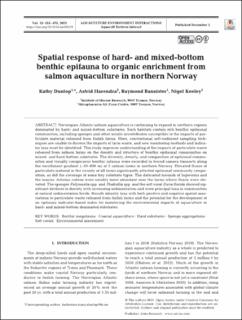Spatial response of hard- and mixed-bottom benthic epifauna to organic enrichment from salmon aquaculture in northern Norway
Peer reviewed, Journal article
Published version
Permanent lenke
https://hdl.handle.net/11250/2839434Utgivelsesdato
2021Metadata
Vis full innførselSamlinger
- Articles [3012]
- Publikasjoner fra CRIStin [3070]
Sammendrag
Norwegian Atlantic salmon aquaculture is continuing to expand in northern regions dominated by hard- and mixed-bottom substrates. Such habitats contain rich benthic epifaunal communities, including sponges and other sessile invertebrates susceptible to the impacts of particulate material released from finfish farms. Here, conventional soft-sediment sampling techniques are unable to discern the impacts of farm waste, and new monitoring methods and indicator taxa must be identified. This study improves understanding of the impacts of particulate waste released from salmon farms on the density and structure of benthic epifaunal communities on mixed- and hard-bottom substrates. The diversity, density, and composition of epifaunal communities and visually conspicuous benthic infauna were recorded in towed camera transects along the enrichment gradient (~50-800 m) of 3 salmon farms in northern Norway. Elevated fluxes of particulate material in the vicinity of all farms significantly affected epifaunal community composition, as did the coverage of some key substrate types. The defecated mounds of lugworms and the seastar Asterias rubens were notably more abundant near the farms where fluxes were elevated. The sponges Polymastia spp. and Phakellia spp. and the soft coral Duva florida showed significant declines in density with increasing sedimentation and were principal taxa in communities at natural sedimentation levels. Results identify taxa with both positive and negative spatial associations to particulate waste released from finfish farms and the potential for the development of an epifauna indicator-based index for monitoring the environmental impacts of aquaculture in hard- and mixed-bottom dominated substrates.
